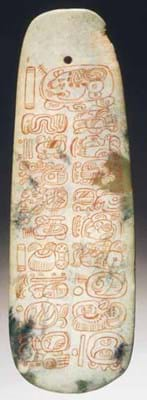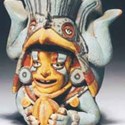Among an exceptional group of jade objects was a Mayan regal belt pendant from the Early Classic period, c.400-500 AD. In the teeth of fierce competition it was knocked down to an American dealer for $1.4m (£760,870), a world auction record for a Pre-Columbian work of art. Such plaques, worn in sets of three, formed part of the most sacred regalia of Mayan rulers, worn only on accession and at death. Only three are known to survive: a companion plaque to this one, recently exhibited in Kyoto, and a slightly earlier example found in 1864 and now in the Rijksmuseum voor Volkenkunde, Leiden. The Christie's plaque was in New York at least by the mid-1970s.
The austerely geometric, powerful art of the peoples who inhabited the Guerrero Mountains in Mexico, struck a chord in the 1960s with collectors of Contemporary art and has held its fascination ever since. An American private collector paid $65,000 (£35,325) for a green-ochre serpentine Late Pre-classic Guerrero-Chontal mask, c.300-100 BC, an auction record for a Guerrero-Chontal mask.
Many of the Guerrero objects offered from this collection had been acquired from the collection of Carlos Gay, pioneer scholar of Guerrero art. An imposing Guerrero-Puebla stone figure from Gay's collection, dating from the Late Pre-classic era, c.300-100 BC, went comfortably over its $40,000 high estimate to sell for $62,000 (£33,695).
A Teotihuacan III alabaster mask, Classic, c.450-650 AD, sold for a low-estimate $200,000 (£108,695).
Possibly the most delightful object in the collection was an exquisitely well-preserved Mayan ritual container, possibly Mayapan, Late Post-classic, c.1100-1300 AD. Formed as a cheerful-looking, diving maize god clutching a cacao fruit, and coloured Maya blue, deep red, black, white and saffron, it had instant appeal and sold to
an American dealer for $160,000 (£86,955). Bursting with energy, it belied its modest 4 7/8in (13.5cm) height.
Exchange rate: £1 = $1.84
Exceptional, market-fresh, private collection makes the most of the Mayans
ON November 12 Christie’s (19.5/12% buyer’s premium) sold a European private collection of Pre-Columbian works of art amassed between the late 1960s and 1980. The market responded enthusiastically to fresh material of high quality with distinguished provenances. Although the lottage rate was only 73 per cent, by value, the sale came in at 93 per cent, a premium-inclusive total of $3.23m (£1.75m).








